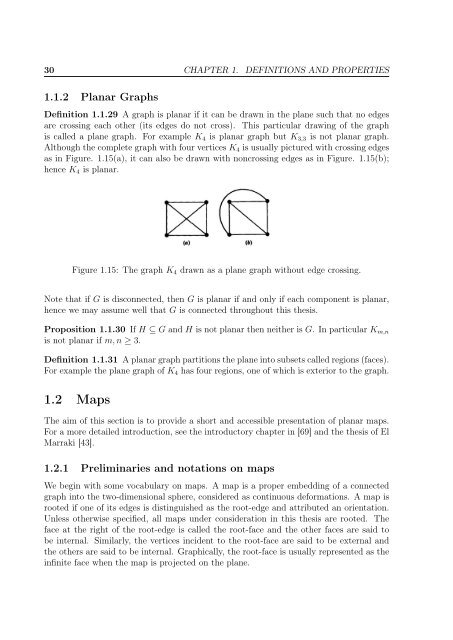enumeration of the number of spanning trees in some ... - Toubkal
enumeration of the number of spanning trees in some ... - Toubkal
enumeration of the number of spanning trees in some ... - Toubkal
You also want an ePaper? Increase the reach of your titles
YUMPU automatically turns print PDFs into web optimized ePapers that Google loves.
30 CHAPTER 1. DEFINITIONS AND PROPERTIES1.1.2 Planar GraphsDef<strong>in</strong>ition 1.1.29 A graph is planar if it can be drawn <strong>in</strong> <strong>the</strong> plane such that no edgesare cross<strong>in</strong>g each o<strong>the</strong>r (its edges do not cross). This particular draw<strong>in</strong>g <strong>of</strong> <strong>the</strong> graphis called a plane graph. For example K 4 is planar graph but K 3,3 is not planar graph.Although <strong>the</strong> complete graph with four vertices K 4 is usually pictured with cross<strong>in</strong>g edgesas <strong>in</strong> Figure. 1.15(a), it can also be drawn with noncross<strong>in</strong>g edges as <strong>in</strong> Figure. 1.15(b);hence K 4 is planar.Figure 1.15: The graph K 4 drawn as a plane graph without edge cross<strong>in</strong>g.Note that if G is disconnected, <strong>the</strong>n G is planar if and only if each component is planar,hence we may assume well that G is connected throughout this <strong>the</strong>sis.Proposition 1.1.30 If H ⊆ G and H is not planar <strong>the</strong>n nei<strong>the</strong>r is G. In particular K m,nis not planar if m, n ≥ 3.Def<strong>in</strong>ition 1.1.31 A planar graph partitions <strong>the</strong> plane <strong>in</strong>to subsets called regions (faces).For example <strong>the</strong> plane graph <strong>of</strong> K 4 has four regions, one <strong>of</strong> which is exterior to <strong>the</strong> graph.1.2 MapsThe aim <strong>of</strong> this section is to provide a short and accessible presentation <strong>of</strong> planar maps.For a more detailed <strong>in</strong>troduction, see <strong>the</strong> <strong>in</strong>troductory chapter <strong>in</strong> [69] and <strong>the</strong> <strong>the</strong>sis <strong>of</strong> ElMarraki [43].1.2.1 Prelim<strong>in</strong>aries and notations on mapsWe beg<strong>in</strong> with <strong>some</strong> vocabulary on maps. A map is a proper embedd<strong>in</strong>g <strong>of</strong> a connectedgraph <strong>in</strong>to <strong>the</strong> two-dimensional sphere, considered as cont<strong>in</strong>uous deformations. A map isrooted if one <strong>of</strong> its edges is dist<strong>in</strong>guished as <strong>the</strong> root-edge and attributed an orientation.Unless o<strong>the</strong>rwise specified, all maps under consideration <strong>in</strong> this <strong>the</strong>sis are rooted. Theface at <strong>the</strong> right <strong>of</strong> <strong>the</strong> root-edge is called <strong>the</strong> root-face and <strong>the</strong> o<strong>the</strong>r faces are said tobe <strong>in</strong>ternal. Similarly, <strong>the</strong> vertices <strong>in</strong>cident to <strong>the</strong> root-face are said to be external and<strong>the</strong> o<strong>the</strong>rs are said to be <strong>in</strong>ternal. Graphically, <strong>the</strong> root-face is usually represented as <strong>the</strong><strong>in</strong>f<strong>in</strong>ite face when <strong>the</strong> map is projected on <strong>the</strong> plane.

















